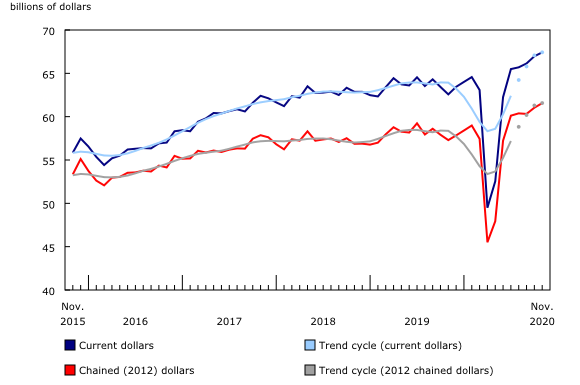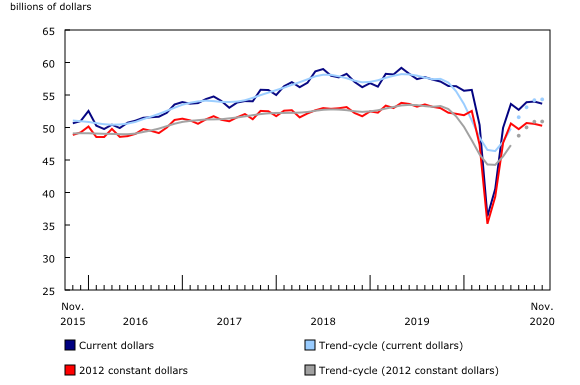Vital updates
- Maj.-Gen. Dany Fortin, leading the logistics of the Canadian vaccine rollout, said that the country will not get any vaccine doses from Pfizer next week. Fortin, vice-president of operations at the Public Health Agency of Canada, said this week’s shipment is almost one-fifth smaller than expected. Procurement Minister Anita Anand said she has spoken to Pfizer and does not expect any more interruptions to its Canadian deliveries after mid-February. Anand says Pfizer is contractually obligated to ship four million doses to Canada by the end of March. This comes on the heels of a recent announcement by Premier Ford that the province is running out of vaccines, and news that vaccine deliveries to Niagara had been reduced. Canada’s rate of vaccination has continued to fall behind that of many peer countries; with a vaccination rate of approximately 1 per 1,000 people, Canada now trails Romania, Finland, Belgium, Austria, Slovenia, Denmark, Lithuania, Spain, Turkey, Ireland, the United States, the United Kingdom, and Israel, among others. The Government of Ontario did announce, however, that the first round of vaccinations had been completed ahead of schedule in all long-term care homes in Toronto, Peel, York and Windsor-Essex.
- Yesterday evening, St. Catharines City Council approved measures aimed at supporting local businesses, including the return of free parking to City spaces and lots, and the extension of its temporary outdoor patio program. With the hopes of drawing more shoppers to the downtown and other commercial areas for their essential needs, parking in all City lots, garages and on-street spaces will be free until the end of April. For more information on parking visit stcatharines.ca/Parking. While parking will be free, the City will continue to enforce parking restrictions related to safety, such as fire routes, as well as restrictions for loading zones and curbside pickup spaces. Additionally, the City’s temporary outdoor patio program will continue until the end of 2021. The program, first introduced in spring 2020, allows restaurant and bar operators to expand outdoor business areas to offset limitations on indoor dining under COVID-19 emergency orders. Staff will also examine the return of temporary downtown road closures during the warmer months to allow for expanded patio operations on weekends.
- Nominations are now open for the 2021 T. Roy Adams Humanitarian of the Year Award. The award honours the memory of the late Councillor T. Roy Adams and is presented annually to a current resident of Niagara who best exemplifies Roy’s values and dedication to community service; a person who sees volunteerism as an integral part of their life. You can view the criteria for the award, and nominate someone you know, on Niagara Region’s website. Nominations are open until March 31, 2021.
-
 Wholesale sales grew for the seventh consecutive month in November—up 0.7% to an all-time high of $67.4 billion. Five of seven subsectors reported stronger sales, led by the machinery, equipment and supplies subsector and the building material and supplies subsector. Notably, the increase reflects higher domestic sales of Canadian goods, as both imports and exports of key commodities fell in November. November sales were 4.4% higher than the pre-pandemic level recorded in February 2020, with six of the seven subsectors’ sales higher than pre-COVID-19 levels. Additionally, all subsectors posted sales in November 2020 that were higher than in November 2019, as was the case for October 2020 compared with October 2019. The performance of the machinery, equipment and supplies subsector, as well as the building material and supplies subsector, has been the foundation of the recovery in the wholesale sector since the spring.
Wholesale sales grew for the seventh consecutive month in November—up 0.7% to an all-time high of $67.4 billion. Five of seven subsectors reported stronger sales, led by the machinery, equipment and supplies subsector and the building material and supplies subsector. Notably, the increase reflects higher domestic sales of Canadian goods, as both imports and exports of key commodities fell in November. November sales were 4.4% higher than the pre-pandemic level recorded in February 2020, with six of the seven subsectors’ sales higher than pre-COVID-19 levels. Additionally, all subsectors posted sales in November 2020 that were higher than in November 2019, as was the case for October 2020 compared with October 2019. The performance of the machinery, equipment and supplies subsector, as well as the building material and supplies subsector, has been the foundation of the recovery in the wholesale sector since the spring. - Manufacturing sales decreased for the first time in three months, declining 0.6% to $53.7 billion in November. Sales were down in 5 of 21 industries, driven mainly by the aerospace product and parts, motor vehicle, and motor vehicle parts industries.
Manufacturing sales in constant dollars decreased 0.6%, indicating that a lower volume of goods was sold in November.
Sales in the transportation equipment industry decreased 9.1% to $8.9 billion in November, following a 0.8% decline in October. Sales rose in the motor vehicle body and trailer industry (+5.9%) and declined in all of the other transportation equipment industries.
Aerospace production fell 23.8% to $1.2 billion in November, following a 5.5% decrease in October. Travel restrictions and market uncertainty attributable to the COVID-19 pandemic continued to negatively affect aerospace production in November. On a year-over-year basis, production was down 45.5%.
Following a 1.7% increase in October, motor vehicle sales decreased 5.7% to $4.3 billion in November. Sales were 10.0% below their pre-pandemic levels in February and down 16.9% year over year. Sales of motor vehicle parts declined 6.0% to $2.5 billion in November and were down 9.7% year over year. Exports of motor vehicles and parts decreased 4.1% in November. Following a 0.2% decline in October, sales in Ontario decreased 0.8% to $25.1 billion in November on lower sales of transportation equipment (-8.1%). Sales declined in most transportation equipment industries in Ontario; decreases were most pronounced in the motor vehicle (-5.4%), motor vehicle parts (-6.4%) and aerospace product and parts (-31.7%) industries. On a year-over-year basis, total manufacturing sales in Ontario were down 3.9%.
Reading recommendations
- 4 Digital Marketing Trends To Watch In 2021, Serenity Gibbons, Forbes
No corner of the marketing world changes faster than digital marketing. As new technology arrives and old technology is grandfathered out, it can be difficult to keep up with all of the new different trends in the industry. Digital marketing has proved itself to be unparalleled in its resilience over the past year: two-thirds of brands have seen a drop in revenue since the onset of the Covid-19 pandemic, and yet over a quarter of marketers are spending 90% or more of their budget on digital marketing according to a survey conducted by the Digital Marketing Institute.
- Trudeau vows to push U.S. on merits of Keystone XL, Canadian Press/BNN Bloomberg
Canada won’t stop trying to convince U.S. president-elect Joe Biden of the merits of the Keystone XL pipeline expansion, Prime Minister Justin Trudeau insisted Tuesday. But even Trudeau’s full-throated defence of the controversial cross-border project, which Biden appears poised to cancel on Wednesday, betrayed a note of resignation. Asked pointedly what he planned to do to rescue the US$8-billion project, the prime minister lingered instead on what he’d done already, including his November phone call with the president-elect.
Niagara COVID status tracker
Niagara’s most up-to-date COVID statistics, measured against the targets for the various stages of the Ontario COVID-19 Response Framework, are presented below. This does not predict government policy, but is offered to give you an idea of where Niagara is situated and how likely a relaxation (or further restrictions) may be. These data are drawn daily from Niagara Region. The Grey-Lockdown level does not have its own metrics, but is triggered when the COVID-specific measurements in a Red-Control region have continued to deteriorate.
Note that the Provincewide Shutdown is not the same as the Grey-Lockdown level listed in the Ontario COVID-19 Response Framework, which has been suspended for the duration of the shutdown. Additional restrictions for businesses apply during the Shutdown. Businesses should not use the Response Framework as a guide during this time, but should instead refer to the Shutdown guidelines.
| December 18 | December 25 | January 1 | January 8 | January 15 | January 22 | January 29 | |
|---|---|---|---|---|---|---|---|
| Reproductive number | 1.4 | 1.8 | 1.4 | 1.1 | 1.0 | 0.7 | 0.9 |
| New cases per 100,000 | 101.2 | 267.3 | 469.8 | 575.8 | 507.1 | 295.5 | 250.6 |
| New cases per day (not including outbreaks) | 60.7 | 178.7 | 311.7 | 376.9 | 325.4 | 182.7 | 145.7 |
| Percent of hospital beds occupied | 97% | 95.2% | 98.2% | 103.2% | 104.5% | 103.6% | 106% |
| Percent of intensive care beds occupied | 78.8% | 77.3% | 87.9% | 87.9% | 90.9% | 89.4% | 93.9% |
| Percentage of positive tests | 6.1% | 15.6% | 28.1% | 28.6% | 26.6% | 21.2% | 16.2% |
Definitions:
- Weekly Incidence Rate: the number of new COVID-19 cases per 100,000 people per week
- Percent Positivity: the number of positive COVID-19 tests as a percentage of all COVID-19 tests performed
- Rt: the reproductive rate, or the number of people infected by each case of the virus
If you are showing symptoms, contact your health care provider, call the Public Health Info-Line at 905-688-8248, or chat to Public Health online. For testing, call 905-378-4647 ext. 42819 (4-CV19) for information on test centres in Niagara and to book an appointment.
Previous updates can be accessed here.
The GNCC is here to support you. Contact us with any questions you have.




